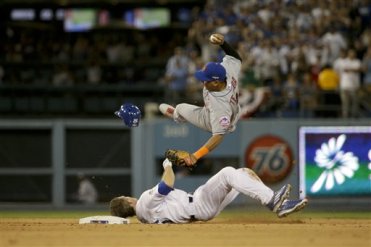Perhaps more than any other sport, baseball is a game of unwritten rules. Players understand what is technically allowed by the letter of the law, but what is nevertheless frowned upon in reality. However, when a situation falls in a sort of grey area, controversy inevitably follows.
Such was the case in Game 2 of the NLDS, when Dodgers veteran Chase Utley slid into second base to prevent a double play, consequently causing a violent collision with Mets shortstop Ruben Tejada, who broke his right fibula as a result of the impact.
This is a very common play. A routine ground ball trickles through the infield to either the second baseman or shortstop, who transfers the ball to the other fielder at second base to start a potential double play. The baserunner, who knows he is going to be out, slides in the path of the fielder to make the throw to first base much more difficult in an attempt to prevent a double play. Sometimes, the runner even tries to intentionally generate contact with the fielder so as to not allow any throw at all and to limit the number of outs on the play to just one. Although there certainly is always the possibility of injury, the majority of these plays do not result in a player being significantly hurt.
On this play, Utley slid hard and, by most standards, late, colliding directly with Tejada’s lower leg, sending him twirling through the air. Tejada had awkwardly spun around to corral the ball and try to touch second base, putting himself in a precarious position as Utley slid in. As he was upended by Utley, Tejada was unable to throw the ball to first to complete the double play because he plummeted to the ground, and was eventually carted off the field with a broken leg.In my opinion, Utley did not make an effort to reach second base safely, as he never even made contact with the bag, but rather impeded Tejada’s ability to throw to first base for the second out of the double play. I would also categorize the play as “clean” rather than “dirty” because there seemed to be no deliberate intent to injure the opposition. Still, despite having very little time to react to Tejada’s spinning maneuver and even having followed traditional coaching for sliding to prevent a double play, Utley could, and should, have slid sooner, so as to have a less forceful impact with Tejada, and made more of an attempt to contact the base.
Now, had Tejada not suffered an injury on the play, would there be a renewed discussion on the dangers of this sort of play? No, probably not. And would Major League Baseball have suspended Chase Utley for two games for his role in the play? No, probably not. But the unfortunate result of the play is not unprecedented – see earlier this season when Jung Ho Kang suffered a season-ending knee injury in a very similar play – and needs to be addressed.
Utley was ultimately able to play Games 3 and 4 of the series on appeal, the hearing for which the MLB has pushed back from this Monday to later in the offseason. Nevertheless, as injuries continue to come about from these double play scenarios, it is time for the league to take a look and consider revising its policies. Player safety should be of utmost concern, and although I am all for good hard play and gamesmanship, this tactic of sliding to break up a double play has begun a descent down a slippery slope and, without intervention from the MLB, could get out of hand.





